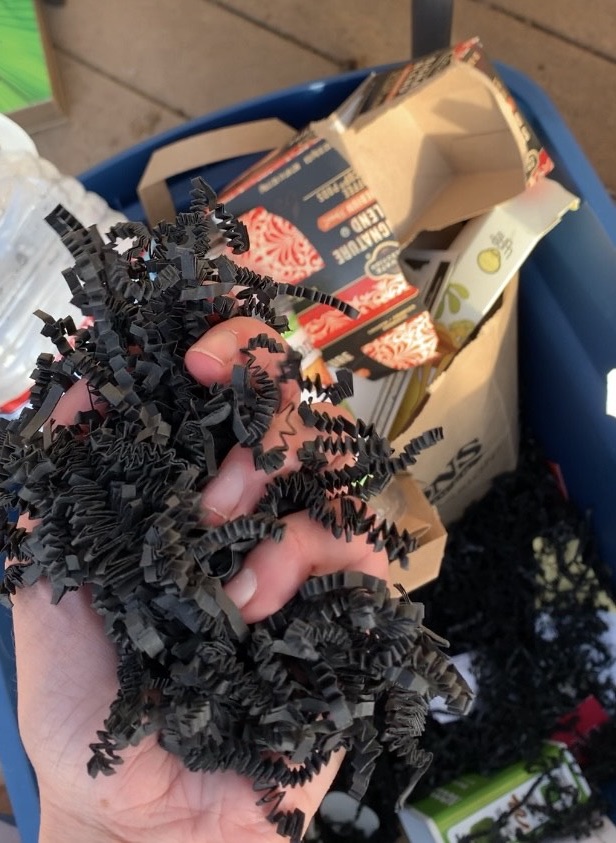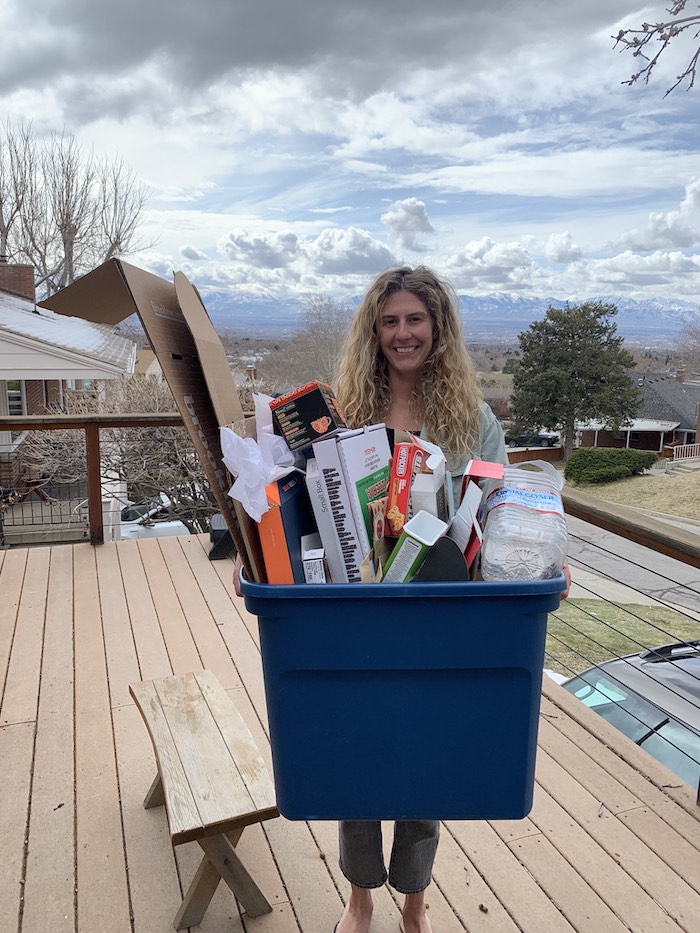I Tracked My Trash for 2 Weeks and Learned an Alarming Lesson About Paper Towels and Packaging
As the commerce writer for Well+Good, I get a lot of stuff. Skin-care products, running sneakers, sous vide gadgets, sexy new vibrators—you name it, and it's my job to try it.
While all of this fun, free stuff certainly comes with its perks, the darker, less glamorous side is that it creates a ridiculous amount of waste. Cardboard boxes, packing peanuts, plastic wrap, frosty bags of dry ice—I could go on and on about how much stuff is leftover from all the stuff I collect. Sadly, most of it ends up in our landfills, contributing to the 292 million tons of municipal solid waste (MSW) created by Americans each year. Even the boxes and bottles I do recycle might not ever make it to the recycling center—it's estimated that less than a third of that waste is recycled or composted annually.
I consider myself an eco-friendly human being... or at least I did. But after tracking my trash output and recycling habits for just two weeks, I was forced to face a major plot twist: I'm not as actually sustainable as I think I am, and I have a lot to learn about the waste management process as a whole.
Over the course of the process, I came face to face with a few little, un-earth-friendly habits that definitely made me raise my eyebrows. Dozens of cardboard boxes and two overflowing trash totes later, I came to a few concerning conclusions. Let us (dumpster) dive in.
@wellandgood She gets *a lot* of packages, so very excited to hear what the sustainability coach has to say! #sustainability #wastenot #earthmonth ♬ Candy Crush - David Das

{{post.sponsorText}}
1. Cardboard is queen (not in a good way)
Part of my job is sampling products, which almost always come packed in cardboard boxes. Throughout this two-week challenge, I logged a total of 24 cardboard boxes that were either discarded from PR mailers (packages editors get from publicists aka PR for companies) or food packaging (I love Hot Pockets, sue me!). This number is surprisingly low. I'm temporarily living in Salt Lake City, so I've significantly cut back on the amount of stuff cycling through my space to avoid having to pack it all when I head home in a few weeks. But back home at my permanent residence in Lake Placid? My mudroom can fill up to the ceiling with cardboard in—no exaggeration—just a few days.

Now, this number doesn't include the number of little cardboard boxes, flyers, or—every journalist's worst enemy—shredded packing paper. Almost every package I receive contains other packages, like skin-care products individually packed in tinier boxes or, in some cases, a whole other box within a box within a box, like a branded nesting doll. If I tallied up all of those tiny, individual packages in that number, I would estimate my grand total would have been closer to 60-70 cardboard boxes overall.
2. Uncovering my paper towel problem
Of all the questionable habits I discovered about myself throughout this challenge, my paper towel consumption was by far the most alarming. Turns out, I use paper towels for everything. Spilled some coffee? Paper towel. Snacking on some mid-day cookies? Paper towel. Microwaving a Hot Pocket? Paper towel. I have a problem, and it's really not good.
This sent me down a rabbit hole of paper towel-y facts: In 2018, the Environmental Protection Agency (EPA) reported that Americans generated around 3.8 million tons of paper waste, like tissue paper and paper towels. On a global scale, it's estimated that 254 million tons of paper towels are thrown away annually. Waste aside, the energy used to make paper towels, napkins, and tissue paper is just as eye-opening. Paper is pulp, and where does pulp come from? Trees. To make just 1 ton of paper towels, 17 trees are cut down and 20,000 gallons of water are polluted, contributing to bigger planetary issues than just what goes into the landfill.
3. Being on the road doesn't help
Many of my habits have shifted over the last four months because I moved to Salt Lake City for the winter, and it's thrown me out of my eco-conscious element. It's no excuse, but there are things I do here that I normally never do at home.
Take drinking water and single-use plastic, for example. Unfortunately, I forgot to pack my favorite filtered water pitcher when we left Lake Placid, and because the air quality is so poor here, I am very suspicious of the tap water. It's reportedly safe to drink, but talk to the locals and they'll tell you otherwise. Cover your ears, but for the past four months we've been buying purified water by the gallon, which I fully acknowledge is unsustainable, but it's a necessary evil for avoiding whatever weirdness is floating around this water.
Same goes for things like K-cups. At home, my partner and I make our morning brew in our Mr. Coffee pot where we compost the filters and the grounds. Out here, the house we're renting has a Keurig... you catch my drift?
It's not easy to stick to sustainable habits at home, but it feels even harder on the road, especially when unforeseen circumstances pop up and economic limitations come into play.
4. Recycling is confusing
Two weeks of tracking my trashy habits brought me to a single realization: does anyone actually know how to recycle?! I sure don't. And the amount of conflicting conversations I had with co-workers, friends, and roommate has convinced me no one else actually knows what they're doing when it comes to waste, either—how to discard it, and where it ends up.

Let's go back to the paper towels. For the longest time, I was convinced you could recycle them. Some of my friends agreed with me—it's paper, right? Wrong. Dead wrong. If they have food waste on them, aka spilled coffee or Hot Pocket residue, you can't. Into the trash they go where they will sit for thousands of years, taking up landfill space and emitting noxious greenhouse gases.
Pizza boxes and coffee cups are the same way. Here I am—along with my boyfriend and roommate—thinking you can just toss them in the recycling to make more pizza boxes and coffee cups to come. Again, wrong, thanks to that food residue. I think if you wash your single-use coffee cup out you might be able to get away with it? But who knows—I sure don't.
And don't even get me started on the more specific stuff, like batteries and lightbulbs. Thankfully, I didn't go through any of these items during this challenge, but what do I do with them when I do? Where do they go? Once again, TBD.
This is all to say I know I'm not the only one who feels this way. There's a reason the EPA has a list that goes through everything from paper and cardboard to used motor oil answering whether or not it can be recycled and how to properly do it. Unfortunately, using, "Well nobody else knows how to do it..." and pointing fingers isn't an appropriate or sustainable excuse.
Thankfully, I'm meeting with my sustainability coach Megean Weldon, next week, who is an expert on all-things eco-friendly. I'm looking forward to learning how to recycle properly, stop "wish-cycling", and getting more tips on all how to decrease my carbon footprint.
Oh hi! You look like someone who loves free workouts, discounts for cutting-edge wellness brands, and exclusive Well+Good content. Sign up for Well+, our online community of wellness insiders, and unlock your rewards instantly.
Loading More Posts...